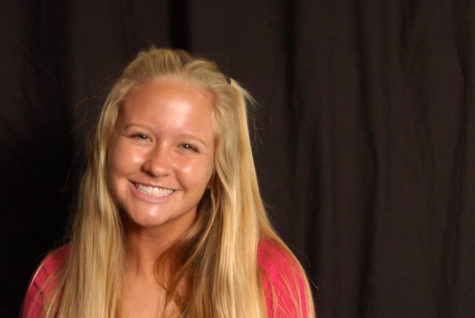One Size Does NOT Fit All
April 18, 2019
Young women everywhere feel ashamed of their bodies no matter their shapes and sizes, and it’s an internal struggle caused by standards that society puts on people.
Girls as early as elementary or middle school begin to wonder if their bodies will ever be considered beautiful by another person, rather than being taught that there is no specific definition of what beauty is.
Too often, popular companies treat unrealistic body types as “better” than others, and promote an idea of what a specific type of “attractive” should look like. Brands like Brandy Melville, Victoria’s Secret, and Lululemon have a history of being exclusive to girls that have plus-sized or curvy figures.
Brandy Melville, for example, has a label on all of their clothes that says “one size fits all,” and that could not be further from the truth. Their clothes are designed to fit roughly a size small, not including larger sizes or even smaller sizes than that.
This sends a message to their consumers, which mostly consists of middle school girls, that the “normal” body type they’re supposed to have is thin, without any curves or fat. The fact of the matter is, one size doesn’t fit all, and it’s exclusive to girls who don’t fit into the image that Brandy is trying to create.
“I strongly oppose ‘one size fits all’ type brands because it is most definitely not true that every body is the same,” says sophomore, Aileen Pham.
Victoria’s Secret has promoted the same idea that the body females should attain, is one that’s tall and slim. Their “Perfect Body” campaign consists of fair skinned, skinny women posing in lingerie, which indirectly shows to consumers that the way to be “sexy” or “desirable” in their bras and underwear is to have a certain body type, which is completely toxic to people trying to find confidence in their bodies.
Not everyone will have a 20 inch waist or DD breasts, and it’s not something to be ashamed of. Beauty is not a definite thing where one has to fit into a certain bra or a certain shirt to fit the standard that companies make, and inflicts on women.
Another issue lies with Lululemon, where it’s rare to find anything above a size 8 in their stores, and they don’t even make anything above a size 12. Their founder, Chip Wilson, has blatantly shamed women for not being incredibly thin, and fitting his idea of what an athlete should look like.
Complaints have come in for the company, with people saying how the pants wear out too quickly, Wilson responded by telling them their bodies aren’t right for the brand because their thighs rub together. He even went as far as to say, “some women’s bodies just don’t work,” insulting every athlete who doesn’t have the “image” that he’s trying to create with his brand.
Thigh gaps have become a goal for many women, especially teenage girls, in past few years more than ever. While it’s possible to have a thigh gap and be athletic, it’s also entirely possible to not have one and be just as athletic.
Associating thinness with health is completely unrealistic, and it’s done too often. Successful female athletes of all shapes and sizes, such as Serena Williams, Olympic tennis player; Michelle Carter, Olympic shot-putter; Carli Lloyd, Olympic soccer player and World Cup Champion, and many more beautiful and powerful women have worked hard to achieve their goals in sports, they don’t need to justify themselves to an exclusive, pretentious brand that thinks a thigh gap defines athleticism.
Rather than putting all kinds of stereotypes and boundaries on the way a woman should look to have praise or recognition, people need to begin understanding that they’re closing their minds to so many people who deserve their respect.




lacie • Apr 24, 2019 at 9:43 PM
amazing!!!! this needs to be shown everywhere because it is so important for everyone to see!!
Xanne • Apr 23, 2019 at 3:19 PM
Great insight ! Love this article and your viewpoint . You have some great points.
Max Katz • Apr 19, 2019 at 12:42 PM
What a great way to give a voice to an issue that is so underrepresented in our media. Amazing article Kate!
Taylor • Apr 18, 2019 at 7:50 PM
Yes Kate!!!! You are a legend!!! This is amazing
maycie • Apr 18, 2019 at 5:23 PM
sorry 4 my typos pls forgive me senpai
Danielle Phipps • Apr 18, 2019 at 4:23 PM
Outstanding article, Kate!! I look forward to more from you. Xoxo
Lizzie Woods • Apr 18, 2019 at 2:43 PM
The most amazing article that everyone needs to read 🙂
leah • Apr 18, 2019 at 1:39 PM
this is a beautifully written article and too true in today’s society. thank you for bringing attention to this issue♥️♥️♥️
Avery • Apr 18, 2019 at 1:33 PM
I love how you focused on how these stereotypes hurt athletes specifically because of this idea that it is not healthy or beautiful for women to be athletic
haylee • Apr 18, 2019 at 1:32 PM
wow!! amazing kate:)) love youuu❤️
Kate Finman • Apr 18, 2019 at 1:06 PM
Great article, Kate! This was really insightful and super important. Great journalism 🙂
grace • Apr 18, 2019 at 12:47 PM
I LOVE THIS! i could not have said it better, this is so true!
Piper Henderson • Apr 18, 2019 at 12:44 PM
KATE!!! YOU ARE AMAZING AND INSPIRE ME AND SO MANY OTHERS EVERYDAY! KEEP IT UP GORGEOUS
Jamie Clark • Apr 18, 2019 at 12:40 PM
Kate!!! You are amazing????
maycie • Apr 18, 2019 at 12:39 PM
great article!! really goods insite into the world of beauty standards for women! 🙂
dani • Apr 18, 2019 at 12:25 PM
PREACH, PREACH, PREACH KATE!!! i love you and am so proud of you, this is beautifully written :))